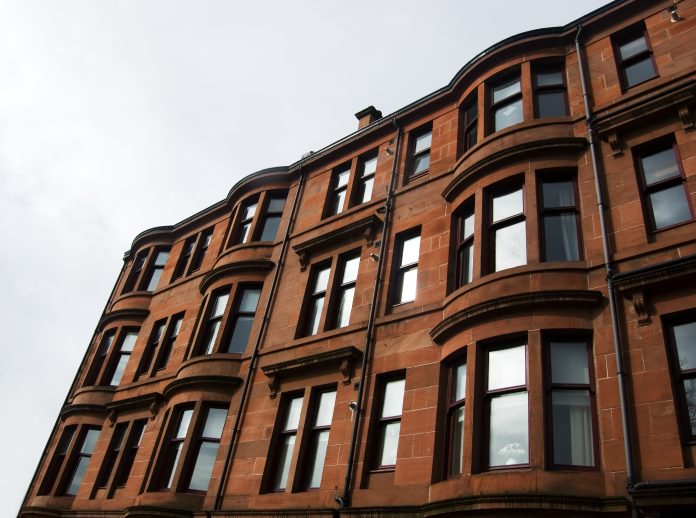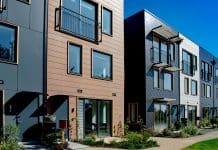With an ambitious, UK-wide goal to reach net zero by 2050, the UK needs to make sure its domestic buildings are up to scratch. But something crucial is still missing: a scalable solution that can be adopted at speed. MMC could provide the answer, says Sam Hart of Built Environment – Smarter Transformation
The UK is dependent on fossil fuels for 78% of its energy needs. While the UK government has committed to lessening its reliance on fossil fuels and reaching net zero by 2050, and the Scottish government by 2045, across the UK we are falling short on ensuring our housing stock is energy efficient enough to reach these goals.
As we find ourselves in the depths of winter, an energy crisis, a recession and with the realities of the climate emergency looming, the House of Commons Environmental Audit Committee has said we need a “national war effort” to make this happen.
Only 11% of homes in Scotland have a renewable heating system
But the scale of the challenge we face is significant. In Scotland alone, there are around 2.5m homes, of which only 11% have a renewable or low emissions heating system and only 45% are at EPC Band C or better.
While in England, within its housing stock of 24.66m, only 41% of homes are at this level.
And despite the fact the UK lags far behind its goal, homebuilders continue to build houses that won’t meet the efficiency standards of a net zero Britain.
If we don’t manage to change this and improve the efficiency of our domestic buildings soon, neither Scotland nor the UK will ever reach their net zero targets in time.
Retrofitting pre-existing housing stock using Modern Methods of Construction
But how do we achieve this at a high standard, quickly and at the scale we need? One of the most promising, potential solutions is retrofitting pre-existing housing stock using Modern Methods of Construction (MMC) techniques. MMC spans a range of approaches from modular to volumetric, but when it comes to retrofit, adopting specialist equipment and technologies to manufacture a panelised retrofit solution offsite would be the most appropriate approach.
Installing these panels into the fabric of a home to improve its efficiency, could be the answer to the nation’s problems. The development of such a solution could also offer a huge commercial opportunity to the construction industry and, most importantly, reduce our emissions and reliance on fossil fuels.
Adopting an approach like this would allow for changes to be implemented at the scale and speed that we need. MMC solutions can be produced, replicated and adopted en masse, therefore increasing both efficiency and productivity, which in the medium to long-term saves economic and environmental costs. And building components offsite instead of onsite is significantly less disruptive for the occupants of the homes being retrofitted.
Despite the need for retrofit and the benefits of an MMC retrofit solution, few companies in the UK market are currently offering this at scale and the sector continues to lack a viable solution to the challenge it faces.
Examples of successful MMC retrofit solutions in Europe
We’ve started to see examples of successful adoption of MMC retrofit solutions in Europe. Dutch-led initiative Energiesprong has, for example, designed an MMC retrofit solution to turn homes into net zero energy homes – meaning that the house generates the energy it needs.
This is done using offsite manufactured components including prefabricated facades, smart heating and cooling installations and insulated rooftops equipped with solar panels that can all be installed without people needing to leave their homes.
While innovations like Energiesprong could solve many of our challenges, in the UK the issue is a little more complex. Much of our housing stock is made up of older and listed buildings. This makes for a tricky balancing act between the necessity to retrofit to improve energy efficiency and the necessity to maintain the historical and cultural importance of a building’s architectural character.
Projects such as Niddrie Road in Glasgow, which looked at the deep retrofit of Glasgow’s iconic pre-1919 sandstone tenement flats, are exploring how this could be achieved.
By retrofitting to EnerPHit energy-efficient design standards, Niddrie Road’s delivery team believes the retrofit will achieve a 90% reduction in energy use, improve quality of life and decrease cost of living for tenants. Nevertheless, with the approach taken in the project, it was not possible to complete the retrofit while the tenants remained in their homes.
MMC is a quality, scalable and sustainable solution
Clearly, we are yet to find a silver bullet for retrofitting the UK’s housing market. But, when it comes to finding a quality, scalable and sustainable solution, MMC could be the missing piece of the puzzle we’ve been looking for. And, with a housing stock of over 24.8m homes that in the next 20 years could require retrofitting, whoever develops the right MMC solution will simultaneously tap into an opportunity that brings significant commercial and environmental benefits.
Across the UK, from the private to the public sector to academia, the government and dedicated R&D facilities like BE-ST, we have the knowledge and resources we need to address the retrofit challenge. But we need to work together to prioritise innovation and find a sustainable solution that can be adopted at the scale and speed we need to decarbonise the UK’s homes, improve the quality of living for their residents and meet our net zero targets by 2045 or 2050.
Find out more about the UK’s retrofitting challenge and Energiesprong here.
Sam Hart
Head of Modern Methods of Construction Programmes
Built Environment – Smarter Transformation

















